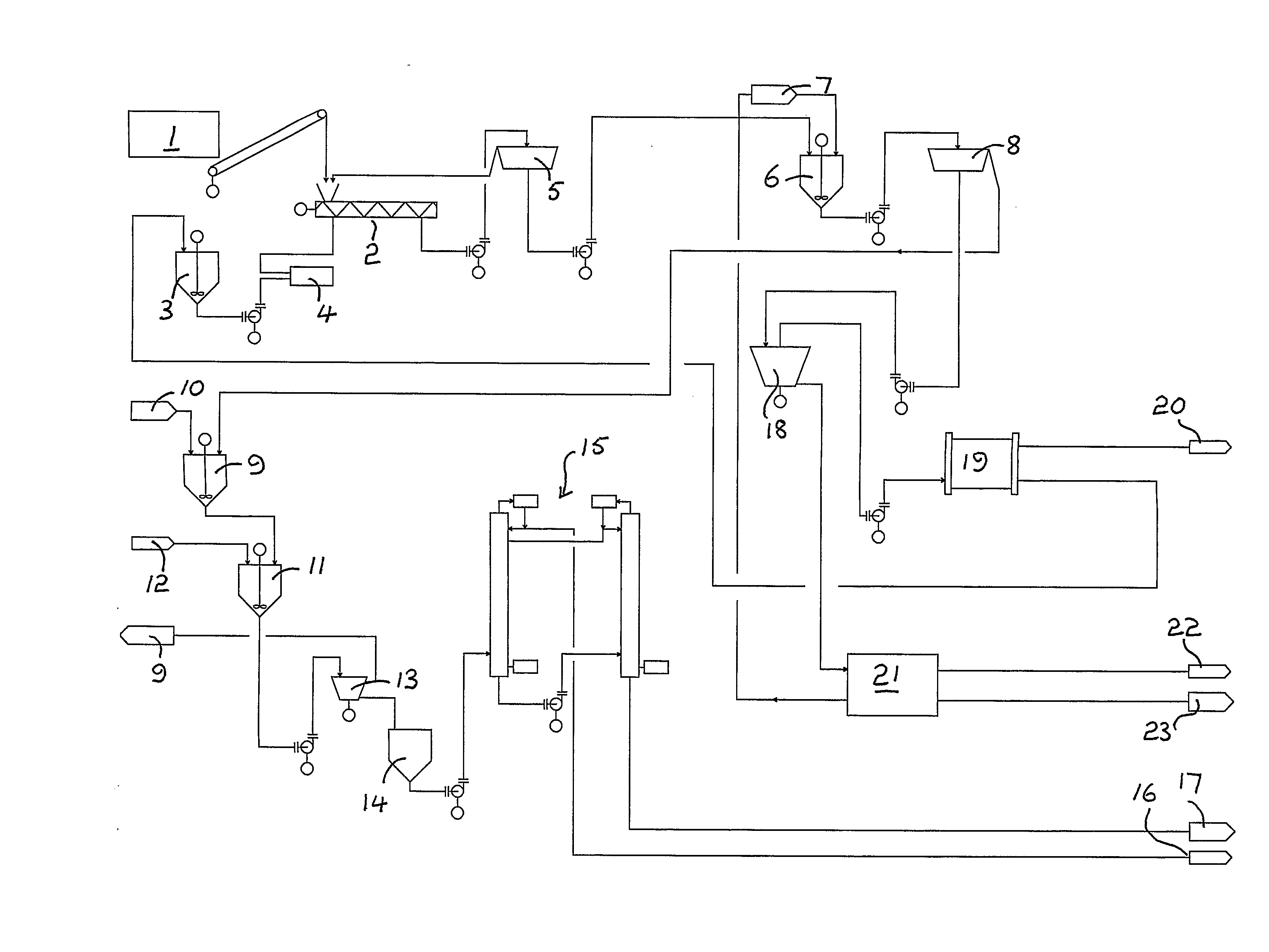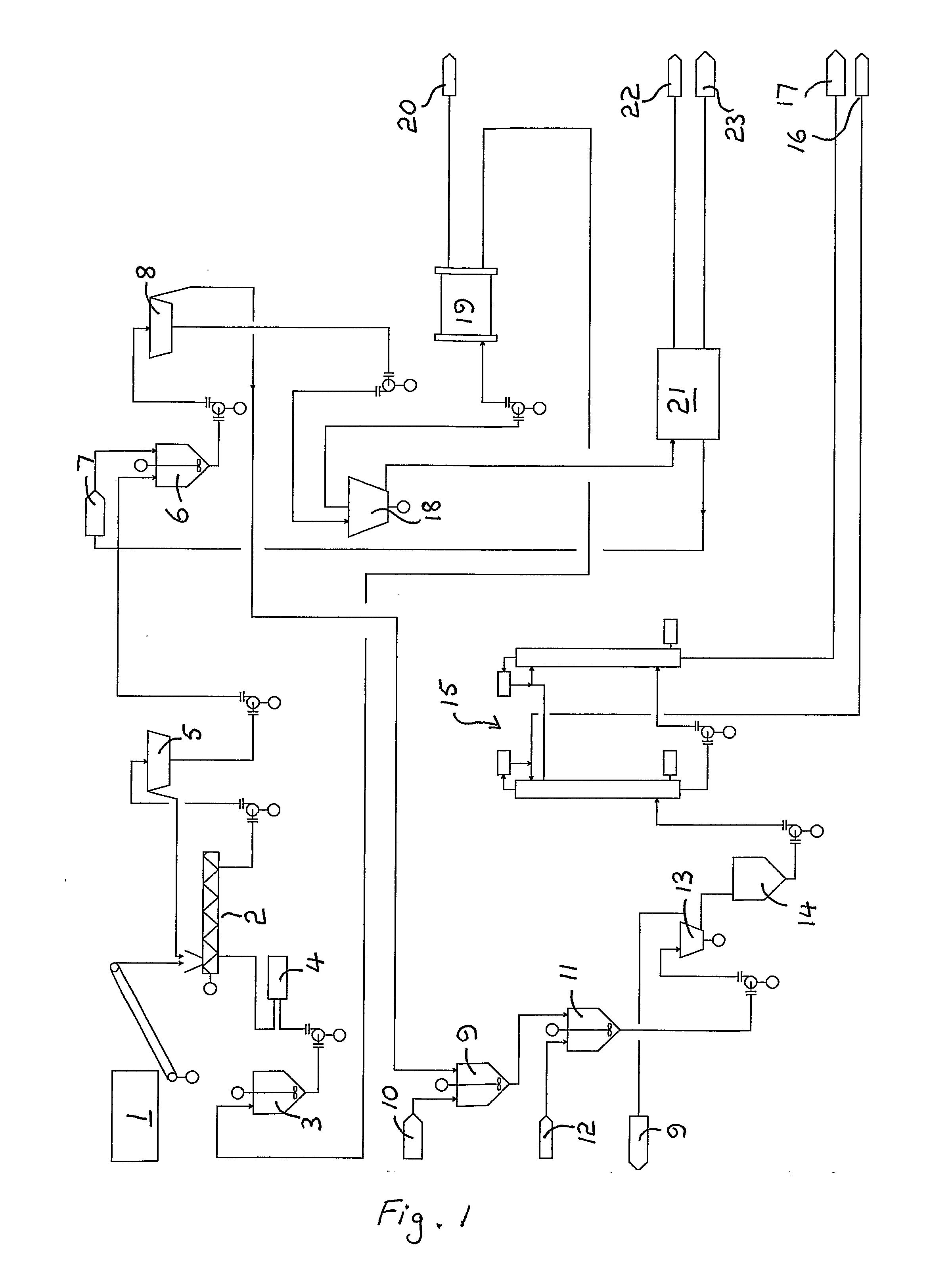Fractionation of a lignocellulosic material
a technology of lignocellulosic material and kraft process, which is applied in the field of lignocellulosic material fractionation, can solve the problems of unsatisfactory separation of lignin from cellulose, unsuitable cellulose for enzymatic degradation, and unfavorable acid hydrolysis, etc., to achieve the effect of reducing the level of ion exchange, facilitating the dissolution of lignocellulosic material, and improving the penetration of ionic liquid
- Summary
- Abstract
- Description
- Claims
- Application Information
AI Technical Summary
Benefits of technology
Problems solved by technology
Method used
Image
Examples
example 1
Dissolution of Wet and Dry Bagasse in 1-butyl-3-methylimidazolium Chloride
[0049]0.0982 g of normal bagasse (at typical or intrinsic moisture level of 58.48% mass water) was added to 6.9440 g 1-butyl-3-methylimidazolium chloride and 0.0411 g of dried bagasse was added to 6.8905 g of 1-butyl-3-methylimidazolium chloride in glass tubes of identical dimensions so that both tubes contained the same dry bagasse:solvent (1-butyl-3-methylimidazolium chloride) ratios. The contents of both tubes were stirred at the same rate and immersed in an oil bath heated to 175° C. to 178° C. Qualitative observations of the dissolution process are reported in the following table.
Time(minutes)Normal bagasseDried bagasse2Moisture condensation onNo changeneck of tubeDarkening of liquid10Small particles all dissolved,Some darkening of liquid,only larger fibres (>0.3 cm)small particles remainremain)undissolved15Large fibres are noticeablySome small particles stillswollenremain20Only ca. 10% of largerSmall par...
example 2
Dissolution of Lignocellulose and Recovery of Cellulose from 1-butyl-3-methylimidazolium Chloride
[0050]2.72 g of normal bagasse (at typical moisture level of 58.48% mass water) was added to 43.18 g of 1-butyl-3-methylimidazolium chloride. The mixture was stirred and heated to 170° C. After ca. 30 minutes the bagasse was completely dissolved. The bagasse in ionic liquid solution was cooled to ca. 100° C. and an aqueous NaOH solution (20 mL of 114 g / L) was added. The resulting mixture contained two liquid phases, namely an ionic liquid phase and an aqueous phase. Upon shaking the aqueous phase became cloudy and dark coloured and the ionic liquid phase became lighter coloured such that it resembled the ionic liquid starting material rather than the bagasse in ionic liquid solution. In addition a precipitate formed in the aqueous phase at the boundary of the two liquid phases. This precipitate could be suspended evenly in the aqueous phase by gentle stirring. The two liquid phases were ...
example 3
Biphasic Ionic Liquid / Aqueous Hydroxide Systems with and without a Halide Salt
[0053]1 mL of aqueous solutions containing sodium hydroxide or sodium hydroxide and sodium chloride mixtures were added to vials containing approximately 0.7 g of 1-butyl-3-methylimidazolium chloride. On addition, the vials were either shaken or not disturbed and then observed over a period of up to 70 minutes. Qualitative observations are reported in the following table. Concentrations are shown in weight / volume percentages.
Aqueous solutiontreatmentobservation10% NaOH + 10% NaClShakenSlow formation of abiphasic system with ahazy interface after 70minutes10% NaOH + 10% NaClNot disturbedFast formation ofbiphasic system withsharp interface in 5minutes5% NaOH + 5% NaClShakenNo formation of abiphasic system after 70minutes5% NaOH + 5% NaClNot disturbedSlow formation of abiphasic system with nosharp interface after 25minutes and unstable20% NaOHShakenFormation of biphasicsystem with sharpinterface in less than ...
PUM
| Property | Measurement | Unit |
|---|---|---|
| Temperature | aaaaa | aaaaa |
| Fraction | aaaaa | aaaaa |
Abstract
Description
Claims
Application Information
 Login to View More
Login to View More - R&D
- Intellectual Property
- Life Sciences
- Materials
- Tech Scout
- Unparalleled Data Quality
- Higher Quality Content
- 60% Fewer Hallucinations
Browse by: Latest US Patents, China's latest patents, Technical Efficacy Thesaurus, Application Domain, Technology Topic, Popular Technical Reports.
© 2025 PatSnap. All rights reserved.Legal|Privacy policy|Modern Slavery Act Transparency Statement|Sitemap|About US| Contact US: help@patsnap.com



